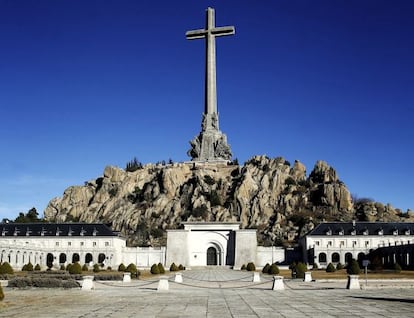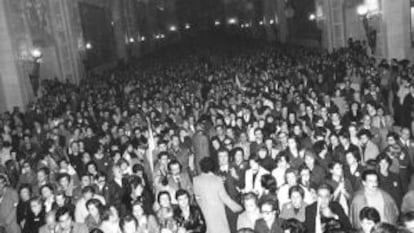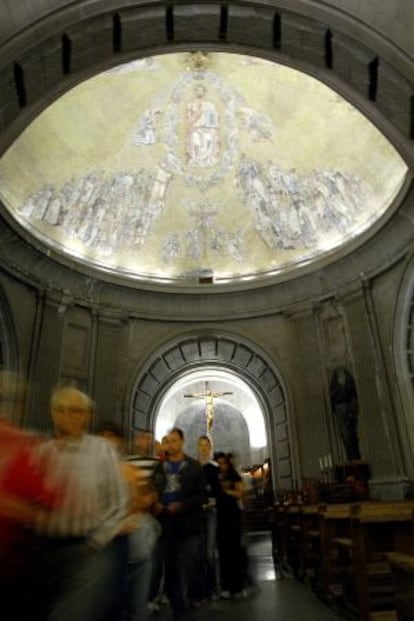The Valley of the Fallen — the problem that won’t go away
Politicans still cannot agree on what to do with the monument that houses Franco’s tomb

“All aboard!” shouts the driver of the bus about to leave the station at San Lorenzo de El Escorial, the picturesque mountain town 50 kilometers northwest of Madrid where Philip II built a vast monastery and palace in the late 16th century. Two young men rush up to the vehicle, and one of them checks that it’s going to El Valle de los Caídos, or the Valley of the Fallen. Aside from the pair, the bus is empty.
“We were visiting El Escorial, and seeing as it’s so close, we thought we’d take a look,” says Rosendo Hernández, a 25-year-old student.
Hernández was unaware that this year marks the 75th anniversary since work began on the Valley of the Fallen, ostensibly built to commemorate those killed in Spain’s 1936-1939 Civil War in an area spread out over 13.6 square kilometers of woodland in the Guadarrama hills.
It’s a hot potato for any government, regardless of its political stripe” Pablo Linares, president of the Association for the Defense of the Valley of the Fallen
The site includes a basilica tunneled into the rockface where General Francisco Franco is buried, along with a Benedictine abbey, a guest house and, of course, its most prominent feature of all, a 150-meter-high cross built on a granite outcrop that towers over the basilica esplanade, visible from 30 kilometers away.
Like most of his generation, Rosendo doesn’t know that this place took two decades to build and that thousands of prisoners of war who fought against Franco in the civil conflict were among the workforce used in its construction.
Visitors numbered around 240,000 last year, a seven-percent drop from 2013 but still making it the fourth-most-visited site managed by Spain’s National Heritage Trust. And like Rosendo Hernández, many of these visitors would like to know more about how the Valley of the Fallen came into being, but will find little enlightenment at the site itself.
From cradle to Franco’s grave

- On April 1, 1940, a year after the end of the Spanish Civil War, Franco decides to build a basilica and monastery at Cuelgamuros, an estate in the Guadarrama hills, around 50 kilometers northwest of Madrid. The aim of the project is to establish "a place of rest and meditation to perpetuate the memory of those who fell in our glorious Crusade." Architect Pedro Muguriza, responsible for the Palacio de la Prensa on Madrid's Gran Vía, is tasked with the design, and picks one of his pupils, Diego Méndez, to help him.
- Republican prisoners of war are offered five days off their sentence for every day worked on the project, possibly along with a small salary. Thousands agree and are shipped off to the site. No figures are available as to the exact number, nor how many died during the construction: some say 15, others as many as 27,000.
- In 1950, Juan de Ávalos wins the contract to design the nine giant figures that decorate the site, some of them 20 meters high: "This is the great sculptor that Spain needs," Franco reportedly said when he saw the scale models.
- On April 1, 1959, after almost two decades of work, Franco presides over the monument's opening ceremony, which coincides with the 20th anniversary of the end of the war.
- Two days earlier, the remains of José Antonio Primo de Rivera are transferred to the basilica, where around 30,000 war dead from both sides are also buried. Only about half of those are accounted for in official records.
- On November 20, 1975, Franco dies. His prime minister, Carlos Arias Navarro, decides the dictator is to be buried alongside Primo de Rivera rather than in the small cemetery in Franco's official residence, as had been planned.
- In the years that follow, the Francisco Franco National Foundation organizes a funeral mass every November 20 in the basilica at the Valley of the Fallen, attracting supporters and far-right groups displaying flags and other Francoist symbols.
- In December 2007, Prime Minister José Luis Rodríguez Zapatero passes a raft of laws aimed at rehabilitating those who suffered under the Franco regime, including a ban on all public displays of Francoist symbols, as well as ending the practice of funeral masses for the former dictator in the basilica, prompting protests from some in the Popular Party.
- On July 13, an arm falls off one of the huge statues situated over the entrance to the basilica, narrowly missing a tourist.
- In November 2008, judge Baltasar Garzón orders the exhumation from the site of eight Republican prisoners who were executed during the Civil War. On November 20 a mass is held, attended by 70 people.
- A few weeks later, the entire site is closed, ostensibly due to danger from falling masonry. Some sections of the media accuse Zapatero of trying to close it permanently.
- In November 2011, a month before general elections, a commission of experts set up to decide the fate of the site publishes its conclusions. It recommends that €13 million be spent on work to prevent further deterioration, and that Franco's remains be removed in a bid to rid the Valley of the Fallen of "political and ideological connotations."
- After winning the elections, the Popular Party ignores the recommendations, and in June 2012, the monument is reopened.
- In December 2014, Socialist deputy Odón Elorza suggests to Congress that the site be converted into a "place of concord and reconciliation," but the motion goes unsupported.
As the bus arrives at the main esplanade, there are just a few parked cars. “Impressive,” says Hernández, looking around him as he climbs out into the crisp mountain sunshine.
“The first thing a kid wants to see when he comes to Madrid is the Santiago Bernabéu Stadium,” says Father Ángel de la Torre, an 80-year-old local resident who knows the monument well. “Two days before it was inaugurated, a cortege brought the remains of José Antonio Primo de Rivera [the founder of the Falange, the fascist-inspired political party that Franco took over, who was killed in the early days of the Civil War] from El Escorial to the basilica.”
With Primo de Rivera in situ, Franco officially opened the complex on April 1, 1959, and a very young Father Ángel sang in the choir. “Our victory was not a partial one, but a total victory, one for everybody,” said Franco, promising to run the country in the interest of all Spaniards.
But 75 years after work began on the Valley of the Fallen, Spaniards cannot agree on what to do with it. “It’s a hot potato for any government, regardless of its political stripe,” says Pablo Linares, president of the Association for the Defense of the Valley of the Fallen.
Around 20 people dot the broad, granite-paved esplanade that opens out before the entrance to the basilica. “We haven’t been inside yet,” says Paloma Martín, a 54-year-old Madrid resident. She visited the complex “years ago, when I was young,” but hasn’t been back since. “There’s something threatening and dark about it,” she adds, looking uncertainly at the huge entrance bored into the rock face.
Before going in, she raises her eyes nervously up to one of the huge figures sculpted around the portal. In 2009, an arm fell off one of them, narrowly missing a visitor. In response to further danger from falling masonry and to carry out repair work, the site was closed in December of that year, prompting criticism of then-prime minister José Luis Rodríguez Zapatero, of the Socialist Party.
In June 2012, with the Popular Party’s Mariano Rajoy in power, the site was reopened, which in turn attracted criticism from the opposition. As the deputy prime minister said at the time, any decision a government takes about the Valley of the Fallen is going to be “difficult.”
In the first six months after the Valley of the Fallen reopened, there were 179,554 visitors, and 259,591 in 2013. Despite a 7.22-percent drop last year, it remains one of the most popular national monuments in Madrid, beaten only by the Royal Palace, El Escorial, and the Aranjuez Palace.
“We include it in our El Escorial package,” says Pedro de la Cerda, of leading tour operator Juliá Tours. “Aside from the curiosity that a place like this arouses, people like the idea of getting two visits for the price of one,” he adds. During the hour-long stay, the guide briefly explains some of the historical context of the site and then leaves visitors free to enjoy the surrounding woodland, which is inhabited by deer, wild boar, foxes, and eagles.
At first, after leaving the bright sunshine behind, it’s hard to see inside the basilica. As her eyes adjust, Paloma Martín picks out a security checkpoint. “I don’t know if I really want to go in,” she says. The click of her shoes on the stone floor echoes as she makes her way down the vast nave decorated with faded tapestries. She passes by six chapels, in the walls of which lie the remains of more than 30,000 war dead from both sides. “It makes me feel a little queasy to be honest,” says Martín, looking around her at the helmeted, sword-bearing angels that line the nave. “It doesn’t look like it’s been looked after much,” she whispers.

National Heritage spends around €340,000 a year on the site, and this money supports the abbey and its 20 Benedictine monks, a school attended by around 50 junior high pupils, a retreat, the basilica and the grounds. “It needs a lot of investment,” says Pablo Linares. “But because it is so controversial, it is being left to wreck and ruin.”
Six months before being voted out of office in November of 2011, Zapatero set up a commission of experts to decide on the future of the Valley of the Fallen. Among them was a monk from the monastery, historians and lawyers, as well as politicians from the two main parties.
Carlos García de Andoin, the secretary of the commission, says the state needs to take a more active role in the site. “It has to be impregnated with Constitutional values so that everybody in society can relate to it. Money has to be spent on renovating and reconfiguring it.” He says that a museum needs to be created there to explain its history, “otherwise it’s not a memorial to the Civil War, but simply a mausoleum.”
Which raises the problem at the heart of the matter: what to do with the bodies of Primo de Rivera and General Franco, as well as the remains of the war dead buried there. There have been suggestions that Franco should be laid to rest alongside his wife in the Pardo, the dictator’s official residence, as was originally planned, but his family refuses to discuss the matter.

Miriam Arraiga, 33, is visiting the site for the first time, and knows little about its history or what should be done with it, other than that she’s unlikely to return. “I have to say that I don’t like the place. It needs a guide or something to explain what all this means,” she says, adding that the information panels in the basilica are of little help.
In the gift shop, all that is available are a few souvenir T-shirts, a recipe book of nuns’ culinary creations, and old-fashioned miniature toy televisions showing slides of the site.
“A museum that gave you some insight into the history of the place would be a good idea,” suggests Rosendo in the cafeteria next to the car park, dominated by the huge cross, its base decorated with the four evangelists and symbols of the four cardinal virtues. The cable car that once rattled up to the cross is no longer in service.
“This place deserves a bit of looking after,” is his final assessment as the bus blares its horn, ready to take its two passengers back to El Escorial.
Tu suscripción se está usando en otro dispositivo
¿Quieres añadir otro usuario a tu suscripción?
Si continúas leyendo en este dispositivo, no se podrá leer en el otro.
FlechaTu suscripción se está usando en otro dispositivo y solo puedes acceder a EL PAÍS desde un dispositivo a la vez.
Si quieres compartir tu cuenta, cambia tu suscripción a la modalidad Premium, así podrás añadir otro usuario. Cada uno accederá con su propia cuenta de email, lo que os permitirá personalizar vuestra experiencia en EL PAÍS.
¿Tienes una suscripción de empresa? Accede aquí para contratar más cuentas.
En el caso de no saber quién está usando tu cuenta, te recomendamos cambiar tu contraseña aquí.
Si decides continuar compartiendo tu cuenta, este mensaje se mostrará en tu dispositivo y en el de la otra persona que está usando tu cuenta de forma indefinida, afectando a tu experiencia de lectura. Puedes consultar aquí los términos y condiciones de la suscripción digital.
Últimas noticias
The new victims of the Republican war on Obamacare: Millions hit by soaring health insurance premiums
A country divided on migrant rights: Some US states expand protections while others restrict them
Venezuela authorizes the release of another 87 political prisoners
There is as much life left to discover on planet Earth as that which is already known
Most viewed
- David King, chemist: ‘There are scientists studying how to cool the planet; nobody should stop these experiments from happening’
- Reinhard Genzel, Nobel laureate in physics: ‘One-minute videos will never give you the truth’
- Oona Chaplin: ‘I told James Cameron that I was living in a treehouse and starting a permaculture project with a friend’
- Sinaloa Cartel war is taking its toll on Los Chapitos
- The Interoceanic Train, the Mexican alternative to the Panama Canal









































